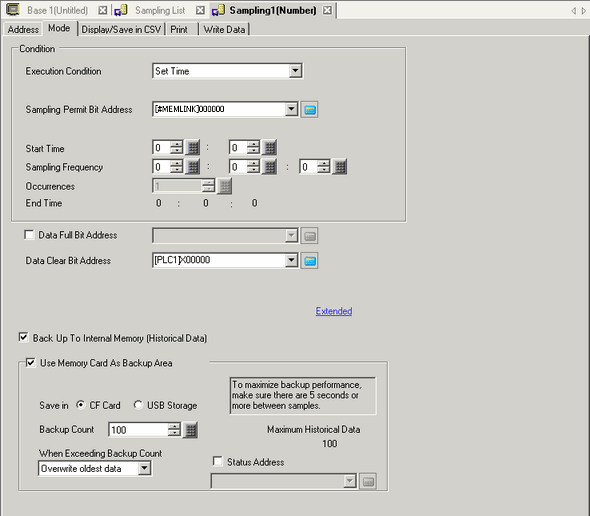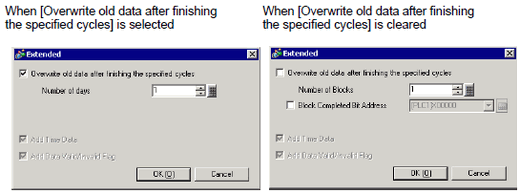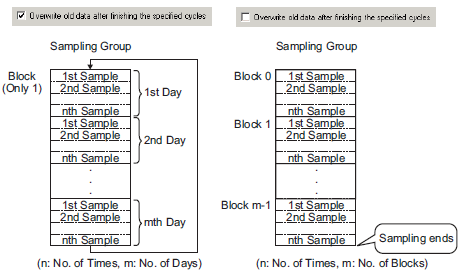
Sample data at constant cycles starting from the designated time.

Execution Condition
Select the sampling action execution condition. Select [Set Time].
Sampling Permit Bit Address
Select the address which will control whether or not sampling will execute. When this address is ON, sampling will begin at the designated [Start Time], and after that, read in data at each cycle of the set [Sampling Cycle].
When this address is OFF, sampling will not occur even when the [Start Time] is reached.
Start Time
Designate the sampling action's start time. Set the time from 0 to 23 (hour), and 0 to 59 (minute).
Sampling Frequency
Set the period that sampling will occur in 15-second increments from 0 sec. to 23 hours, 59 minutes, 45 sec.
Occurrences
Select the number of times sampling will occur. If in the [Extended] area the [Overwrite old data after finishing the specified cycles] check box is selected, this can be from 1 to 65535 times. If the check box is cleared, the range is from 1 to 2048 times.
![]()
The settings range will be limited to ensure that the period from [Start Time] to [End Time] is within 24 hours. As well, the number of sampling groups and number of addresses (number of words) in the whole system will also be limited.
End Time
Set the [Start Time], [Sampling Cycle], [Number of Times], and the sampling end time will be displayed.
Data Full Bit Address
After all the sampling is completed (after the designated [Number of Times] * [Blocks], or [Number of Times] * [Number of Days]) this bit address will turn ON to confirm that the operation is finished. To confirm, set this address.
In the Extended area, when the [Overwrite old data after finishing the specified cycles] check box is selected, this bit tells when a data sampling cycle has been done. The sampling action will continue running even when this bit is ON.
If not designated, the sampling action will end when this bit turns ON. Please turn OFF the [Data Clear Bit Address] to resume.
![]()
This address is not turned OFF automatically. If the [Overwrite old data after finishing the specified cycles] check box is selected, please ensure that the bit is turned OFF in order to confirm the next sampling cycle.
Data Clear Bit Address
Designate the bit address to control the clearing of the sampling data. When this address turns ON, all the Sampling Group data stored in the display unit will be erased. After clearing the data, this bit will turn OFF.
Extended
Displays the [Extended] dialog box.
The contents is different depending on whether the [Overwrite old data after finishing the specified cycles] check box is selected or cleared.

Overwrite old data after finishing the specified cycles
Select whether or not the data will be overwritten and stored, starting with the oldest data, after data has been sampled the designated number of times.
If this is set, even when all the data sampling has completed ([Number of Times] x [Number of Days]), sampling will continue and data, starting with old data, will be overwritten.
If this is not set, previous data will not be overwritten. The new rounds of data will be stored as separate blocks. After all data has been stored ([Number of Times] x [Blocks]), sampling will not occur until all stored data has been deleted.

Number of Days
Designate how much sampling data should be maintained inside backup SRAM (or DRAM). Data from the designated number of days is stored, and then overwritten in order, starting with data on the first day. The setting range is from 1 to 2048. The setting range is limited to ensure that the amount of [Number of Times] x [Number of Days] is 65535 or less.
Blocks
The complete set of data collected in the designated number of times is called a [block]. Designate the number of blocks to set inside one Sampling Group. The setting range is from 1 to 2048.
The settings range is limited to ensure that the amount of [Number of Times] x [Blocks] is less than 65535.
Block Completed Bit Address
After the sampling for one block of data (the designated number of times) is completed, this bit address will turn ON to confirm that the operation is finished. To confirm, set this address.
This tells that one block's sampling has completed. The sampling action will still continue for the designated [Blocks].
![]()
This address is not turned OFF automatically. In order to verify completion of the next block, please ensure that this bit is returned to OFF.
Add Time Data
The sample time will be stored along with the sampled data. This setting is fixed to enable.
Add Data Valid/Invalid Flag
Stores an observation flag along with the data which monitors if the data has been saved properly. This setting is fixed to enable.
Back Up To Internal Memory (Historical Data)
Select whether or not to save the sampling data to the backup SRAM. If the sampling data is not saved, the data will be deleted when the power to the display unit is turned OFF or reset.
![]() 24.11.1 Data Storage Locations
24.11.1 Data Storage Locations
Use Memory Card as Backup Area
Indicates whether data saved in the backup SRAM is written to the location specified in [Save in]. The data is saved in binary format.
![]() 24.11.1.1 Usage Capacity of Sampled Data
24.11.1.1 Usage Capacity of Sampled Data
![]()
When selecting this item, precautions on backup to a memory card and the maximum number of historical data that can be displayed in the Historical Trend Graph are displayed on the right-hand side. The maximum number is "Number of Times" of the condition x "Backup Count".
Save in
Select the "Save in" location of the backup data, from [CF card] and [USB storage].
Folders are automatically created for each sampling group in the "Save in" location. The saved file name will be Time Stamp (year/month/day/hour/minute/second when saved).
For example, when it is saved at 14:30:5 on July 2 in 2007
\SAMP**\T070702_143005#.bin
("**" represents sampling group number and "#" represents index number)
![]()
The index number for file names is from 0 to 9. You can save up to 10 files at the same time.
Backup Count
Specify the number of times (1 to 500) to write the backup data. The number specified here is the number of files that will be created.
When Exceeding Backup Count
Select an action when the number of backup files exceeds the value set in the Backup Count.
Overwrite oldest data
Delete the oldest file and add a new file.
Interrupt Backup
Stops backup. "1001" (number of files exceeded) is stored in the status address.
Status Address
Indicates whether the saved operation status and error information are stored in the specified address.

The error status indicates the following error codes.
Error Code
|
Bit 12 to 15 |
Contents |
Details |
|---|---|---|
|
0000 |
Completed Successfully |
Transfer completed successfully. |
|
0001 to 0011 |
Reserved |
— |
|
0100 |
No CF Card or USB Storage |
When a CF Card/USB Storage device is not inserted while backing up a file in binary format, or the CF Card cover is open. |
|
0101 |
CF Card/USB Storage Write Error |
The capacity of the CF Card/USB Storage device is insufficient or the CF Card/USB Storage device is removed while saving a backup data file in binary format. 10 backup data files with the same time stamp already exist because the time set of the display unit was restored, etc. |
|
0110 |
Reserved |
— |
|
0111 |
CF Card Error |
Occurs when the CF Card is unformatted. |
|
1000 |
Reserved |
— |
|
1001 |
Excess Number of Files |
Exceeded number of files set |